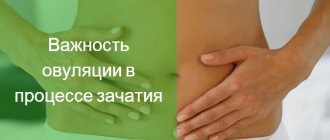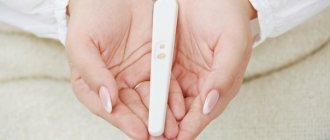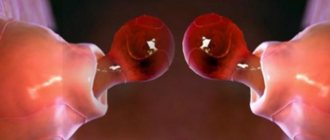Why is there no ovulation?
Ovulation in women is a process that should occur monthly. In this case, the egg, which has already matured, leaves the follicle into the fallopian tube and moves towards the uterus. Sometimes this doesn't happen. There may be various reasons for the lack of ovulation, there are a huge number of them.
Anovulation can be affected by:
- the presence of pregnancy (ovulation does not occur in pregnant women);
- period after delivery;
- 2-year period after the start of menstruation;
- period of breastfeeding (lactation);
- menopause;
- taking birth control pills, hormonal drugs (in such cases there is no ovulation and this is the norm);
- Once or twice a year, a healthy woman may not release an egg.
All of the above factors relate to the physiological absence of ovulation. It can occur at any time, after the cause has been eliminated.
But there is also pathological anovulation. Arises due to:
- Sudden weight loss or, conversely, weight gain. During this, the hormonal background changes, and the woman also does not have enough resources in the body to produce germ cells.
- Diseases from the field of endocrinology. If there is no ovulation, the reason may be due to improper functioning of the thyroid or adrenal glands.
- Head injury.
- The presence of a tumor in the pituitary gland.
- Excessive production of prolactin by the pituitary gland.
- Poor blood circulation in the brain.
- Improper functioning of the hypothalamus.
- Gynecological diseases (due to polycystic disease, changes occur in the functioning of the ovaries, their structure also changes).
- Congenital anomalies of the ovaries. Such deviations are rare, but they do occur.
- Inflammatory and infectious diseases. Lack of ovulation can be caused by chronic inflammation that lasts for a long period of time.
- Great physical activity. Women athletes (ballerinas, track and field athletes, weightlifters, etc.) suffer the most. This work provokes suppression of the maturing follicle.
- Stress. Severe breakdowns, prolonged nervous experiences and all kinds of stressful situations have an impact.
- Using certain medications. Menstruation without ovulation occurs when taking hormonal drugs and antidepressants.
What if your hormones are normal and you have regular periods? In this case, you should undergo an examination, because the reason may be completely different. If the hormones are normal, it may be a hereditary factor, a congenital ovarian defect, or a serious cancer.
Sometimes everything is much simpler and depends on scanty or, on the contrary, heavy periods, restructuring of the body. In any case, you need to undergo diagnostics and determine the essence of the problem.
Hyperovulation method
Which stimulation method should I choose? Stimulation of ovulation can be carried out using different methods, which detail the regimen, dose and duration of therapy. The doctor chooses the research method, taking into account the following factors:
- the result of assessing the ovarian reserve;
- woman's weight;
- the effect of previously performed stimulations (if there were any).
All medications used at the time of stimulation are classified as hormonal, but they differ from each other in the type of hormone on the basis of which they were produced. Luteinizing or follicle-stimulating agents are used to preserve the functions of the egg and its accelerated development. Ovulation has disappeared - how to restore it?
Experts identify the following main methods of stimulating ovulation:
- HMG-based products, which include FSH and LH hormones in equal quantities. These include “Pergonal”, “Menopur”, “Menogan”.
- Preparations containing FSH: the principle of operation of such hormones is very close to the natural process.
- Drugs whose action is based on reducing the amount of estrogen and increasing FSH to the required amount.
- Hormonal drugs that help quickly rupture the follicle membrane and ensure rapid release of the egg.
Most often, when preparing treatment, doctors prescribe combined stimulation.
How to find out that there is no ovulation?
How to determine the absence of ovulation? You can do this yourself or in a hospital. Of course, a specialist will answer this question more accurately and confidently.
Can ovulation be absent during regular periods? Yes, it's quite possible. A doctor will help you find out the cause.
Arriving at the appointment, the woman must prepare a full story about what changes have occurred in the body recently. What is important is the length of the menstrual cycle, the nature of the discharge during menstruation, whether there was a sudden loss or gain of weight, and what concomitant diseases are present. The doctor will also ask if the lady smokes and how often she drinks.
Having calculated the day of ovulation approximately this month, the specialist will refer the patient to donate blood. Taking into account the results of the analysis and the entire collected history, we can determine the absence of ovulation.
Another method that is used in clinics is ultrasound. You will have to do it more than once. The processes that a specialist sees on the screen for 2-3 months will allow one to draw appropriate conclusions.
Anovulation during regular periods can be easily determined at home on your own. For this:
- basal temperature is measured;
- a calendar is maintained;
- an ovulation mini-microscope or test strip is used.
When measuring basal temperature with a mercury thermometer over a long period, you can understand whether the egg is maturing or not. When the follicle bursts, the degrees rise to 37. On ordinary days, the readings do not exceed 36.6 degrees. For the most reliable result, you need to compare at least three menstrual cycles (measure temperature over three months).
If something goes wrong, you can consolidate the result and more accurately verify the absence of ovulation. A special test will help with this. It can be purchased at a pharmacy. It is a paper strip on which two lines are displayed when ovulation occurs (it resembles a pregnancy test). Another reliable tester is a mini ovulatory microscope. It is necessary to check saliva or cervical mucus.
You can listen to your body. Sometimes changes in the nature of discharge, behavior, taste preferences, libido, etc. indicate the onset of ovulation. During this period, the discharge becomes viscous and stretchy. The mammary glands swell and ache. Some ladies have pain in the lower abdomen or side. I also really want intimacy. If such symptoms are absent, then this may indicate a pathology is present.
Can there be pain after stopping birth control?
When a woman takes OK, her ovaries are in a dormant state. If you stop taking it, the activity of the reproductive system increases. This period can reach 3 months. As a result of increased activity, pain of a pulling nature appears in the lower abdomen.
You can learn how to get pregnant after stopping contraceptives if you watch this video:
But pain may be due to other reasons:
- follicle rupture;
- high contractility of the fallopian tubes;
- irritation of the ovary, in which the organ secretes fluid that penetrates the peritoneal area and pain occurs;
- changes in hormone levels;
- inflammatory process in the fallopian tubes;
- neoplasms.
The pain can last from a few minutes to a day. If it cannot be tolerated, it is better to make an appointment with a gynecologist. The specialist will prescribe the necessary painkillers to alleviate the condition and conduct an examination.
The onset of ovulation after discontinuation of OCs is an individual process that depends on many factors. Therefore, the use of oral contraceptives is a serious step. It is not recommended to self-prescribe such drugs. Before taking it, you must consult a gynecologist. The specialist will conduct an examination and prescribe the necessary drug.
I stopped taking the pills 4-5 months ago and have not yet become pregnant. I bought an ovulation test. Now I’m in the middle of my cycle, but the test still hasn’t shown ovulation. I don’t know what to do and how to restore reproductive function. The doctor said everything was normal. I'm 35.
Woman.ru experts
Find out the opinion of an expert on your topic
Vorobyova Yulia Nikolaevna
Psychologist. Specialist from the site b17.ru
Wrzecinska Eva
Psychologist. Specialist from the site b17.ru
Leontyev Denis Borisovich
Psychologist, Psychoanalyst. Specialist from the site b17.ru
Muzik Yana Valerievna
Psychologist, Psychoanalyst. Specialist from the site b17.ru
Mishurov Sergey Valentinovich
Psychologist, Consultant Sexologist. Specialist from the site b17.ru
Antakova Lyubov Nikolaevna
Psychologist, Consultant. Specialist from the site b17.ru
Boldova Olga Ivanovna
Psychologist, Supervisor, Medical psychologist. Specialist from the site b17.ru
Spiridonova Nadezhda Viktorovna
Psychologist. Specialist from the site b17.ru
Bykova Svetlana Viktorovna
Psychologist, Consultant - Dialyst. Specialist from the site b17.ru
Diagnosis before starting therapy
To begin treatment to restore ovulation, you need to clearly know why ovulation does not occur. The doctor will first prescribe measures such as:
- ovulation test;
- blood tests for hormones;
- diagnostic endometrial curettage.
The test, as mentioned above, can be carried out at home, but within the walls of the clinic, it is done by specialists, so there is no doubt about the result. They also use a test strip, a digital test and an electron ovulatory microscope.
Afterwards you need to donate blood. It will determine the level of certain hormones. The analysis is taken from the second to the fourth day of the cycle. This must be taken into account, because the concentration of hormones changes in different phases. You need to check the level:
- prolactin;
- T4-free and T3;
- total testosterone;
- DEAS;
- 17-hydroxyprogesterone;
- cortisol;
- anti-Mullerian hormone.
All indicators are important in making a diagnosis and in prescribing further therapy.
Ultrasound examination helps to find structural changes in the ovaries (for example, polycystic disease or tumor), inflammatory diseases, and determines signs of lack of ovulation. This can be seen by the number of follicles and their size, modification of the endometrium, etc. The specialist will first of all look for a dominant follicle; if it is not there, then it is anovulation. In order for the results to be true, ultrasound is done several times.
Diagnostic curettage is common in gynecology. It is done when:
- irregular periods;
- metrorrhagia (bleeding that occurs between periods);
- menorrhagia (long and heavy periods);
- algomenorrhea (pain during menstruation);
- bleeding during menopause;
- infertility;
- suspected uterine cancer;
- spontaneous miscarriages;
- endometritis, etc.
Such curettage will also help to understand why there is no ovulation during regular periods. It cannot be performed if there are acute infectious and inflammatory diseases in the cervical canal and vagina. Curettage should be done in the 2nd phase of the menstrual cycle to avoid extensive bleeding.
Before the procedure, it is necessary to carry out preparations (a smear is taken from the vagina, culture of secretions, general and biochemical blood tests, general urinalysis). Immediately before the procedure, a woman should not take any medications, not have sex, not use any deodorized intimate products, douche in the vagina or any other similar manipulations. Also, refrain from eating and drinking twelve hours before surgery. For the anesthesia to go well, you need to do it on an empty stomach.
The curettage itself is done under stationary conditions in a special operating room. First, anesthesia is administered as the procedure is painful. First, the cervix is dilated. For this purpose, a Hegar expander is used. Afterwards, the mucous membranes are scraped. To do this, use a surgical spoon - a curette. The procedure can be carried out with hysteroscopy, then all actions will be viewed, but this is not always necessary.
Tactics for anovulation
Women often ask their gynecologist how to get pregnant if there is no ovulation. Without treatment this is impossible. Fertilization can occur only after ovulation, usually on days 12–16 of the cycle, since the lifespan of the egg is short.
Anovulatory cycles are currently a common cause of female infertility.
If pregnancy does not occur within a year, and there is suspicion of this pathology, a consultation with a gynecologist is necessary. It is he who will determine what to do if there is no ovulation.
With anovulatory cycles, it is very important to determine the cause of the disease. In most cases, such infertility is treatable.
Pills to restore ovulation
What to do to get pregnant? If ovulation does not occur, then it must be stimulated. Special medications help induce ovulation. The tablet form is quite common.
The most popular tablets:
- Duphaston;
- Utrozhestan;
- Clostilbegit;
- Puregon;
- Pregnil et al.
Duphaston
prescribed to improve the functioning of the ovaries. Drink twice a day (20 mg in total) from days 14 to 25 of the cycle. This is the best time, the egg leaves the follicle and moves on. The diagram is indicative, all the exact prescriptions are given by the doctor.
Utrozhestan
usually prescribed according to the same regimen as Duphaston. Twice a day from 15-15 days to 24-25 days of the menstrual cycle.
Klostilbegit
taken both independently and in combination with other drugs.
On days 6-8 of the cycle, take one tablet once a day. If together with Puregon
, then from the third day they drink Clostilbegit and stop on the seventh day. From the eighth grade they take Puregon tablets.
Decayed
is prescribed when an ultrasound shows that the follicle has reached the desired size.
Injections to restore ovulation
Menogon and Puregon are used as injections.
In the absence of ovulation, treatment with Menogon begins at the beginning of the cycle. Over the course of seven days, 75-150 IU are administered. All doses are prescribed by the doctor depending on the result obtained and the symptoms present.
Menogon
start within the first 7 days of the menstrual cycle. It is recommended to administer 75 to 150 IU of Menogone for at least 7 days. The dosage is not increased earlier than after a week. Maximum – 225 IU.
Puregon
It is also prescribed to be administered in the first week in one dosage, after which it is increased, the whole process is monitored. The initial dose is 50 IU, then everything is determined by the attending physician.
Drugs to reduce prolactin levels in the blood
The most effective and popular medications that lower prolactin are:
- Dostinex;
- Bromocriptine;
- Cabergoline.
Dostinex
- 4.5 mg (1 tablet) divided per week. Can be divided into 2-3 doses.
Bromocriptine
– initially drink 1.5 mg two or three times a day. The dosage is gradually increased to 7 mg per day.
Cabergoline
– at first, take 1 tablet once a week or divide it into two doses. Further increases in the dose are controlled by the doctor. No more than 4.5 mg per week.
Laparoscopy
If there was no ovulation in this, last and other months, this is a pathology. Sometimes it is treated with laparoscopy. This mini-operation allows the egg to be released to meet the sperm. The surgeon makes punctures in the peritoneum, through which he makes micro-incisions in the ovarian capsule. Through them the egg has a free exit.
When there is no ovulation, in some cases there is only one way out - in vitro fertilization. This technology is used to treat infertility. During the procedure, an egg is taken from the female body and artificially inseminated. The embryo develops in the incubator for no more than five days, after which it is transferred to the uterine cavity, where it continues to develop.
Traditional recipes for stimulating ovulation
How to restore ovulation using traditional methods? There are folk recipes that help solve the problem of lack of ovulation during regular periods.
You can use a decoction of sage and boron uterus. To prepare, take a tablespoon of each plant and pour in 500 ml of boiling water. All is infused for 3 hours, filtered. You need to drink 10 ml three times a day for 15 days from the beginning of the menstrual cycle. If pregnancy does not occur this month, everything repeats again.
Another remedy is mumiyo. The drug is used for infertility 0.2–0.3 g twice a day on an empty stomach in the morning and evening, before going to bed. You need treatment for about a month.
Inducing ovulation using folk remedies can only be achieved under the supervision of a doctor. You shouldn't do this yourself.
And finally, I would like to say that if a woman has regular periods, this does not mean that she is ovulating. If she is missing, but the lady wants to get pregnant, try:
- Healthy food;
- take more vitamins;
- promptly treat all gynecological diseases;
- do not change sexual partners frequently and have a regular sex life;
- listen to your body and if there are any abnormalities, go to the hospital;
- give up bad habits;
- do not do backbreaking, hard work;
- Be less nervous.
If even after following all the above points there is no ovulation, go to the hospital. A specialist must determine why the egg cannot be released. Timely treatment will help you get pregnant and learn what motherhood is.
←Previous article Next article →
Every month, a tiny sac, a follicle, containing an egg, matures in a woman’s ovary. Around the middle of the cycle, it leaves the follicle - this is ovulation. The egg is then captured by the fallopian tube and travels down it into the uterus. This process is controlled by hormones produced in the brain and ovaries. In addition, the development of the egg can be influenced by processes occurring in other organs and tissues, for example, in the thyroid gland, adrenal glands and adipose tissue. Dysfunction of any of these organs and tissues leads to a failure in the maturation of the egg. A menstrual cycle in which there is no ovulation is called an anovulatory cycle. The absence of ovulation is also called anovulation.
What if there is no ovulation?
Unfortunately, a woman may not even know that her egg is not maturing and is not being released, because often her periods proceed in a normal rhythm. But in such cases, problems arise with conception, since if the egg does not leave the ovary, it means that the sperm has nothing to fertilize, and it is clear that in this case pregnancy cannot be expected.
Ovulation disorders can occur for a variety of reasons. Some of them are physiological, others are associated with diseases of both reproductive and other systems and organs.
No ovulation: reasons
It should be noted that healthy women do not ovulate every month. In addition, there are periods of life when it does not happen at all. So, older women do not ovulate during menopause, and nothing can be done about it. The number of ovulations per year begins to decrease at approximately 30 years of age (some earlier, some later). In very young girls, anovulatory cycles occur 1-2 times a year, in women over 35 years old - every second month, and by the age of 45, 3/4 of all cycles are anovulatory cycles. For this reason, the older a woman is, the more difficult it is for her to get pregnant. The absence of ovulation in pregnant women, as well as in nursing mothers in the first months after childbirth (provided that they exclusively breastfeed the baby on demand), is considered completely normal, which is combined with amenorrhea (lack of menstruation).
There are other reasons for ovulation disorders. Severe emotional shock (death of loved ones, serious problems in family life), constant stress can lead to a complete absence of ovulation while menstruation continues. Ovulation disorders can also occur “thanks to” intense physical activity, chronic fatigue, long travel and climate change. In all these cases, a failure in egg maturation is caused by the body’s protective reaction to overload.
Often, the absence of ovulation is observed in women weighing less than 45 kg and with a sharp decrease in body weight by 5–10% per month. Researchers have found that for ovulation to occur, 18% of a woman’s weight must be adipose tissue, since the hormone estrogen accumulates in fat cells and the hormones responsible for the maturation and release of the egg are converted. If the amount of hormones is insufficient, menstruation disappears, therefore there is no ovulation. But even with excessive deposition of adipose tissue, the same result is possible - not only low hormone levels have a negative impact, but also high ones.
The absence of ovulation in women taking oral contraceptives and using other methods of hormonal contraception is also considered normal. After all, the effect of the drugs is precisely to suppress the maturation of the egg. Sometimes, after long-term use of oral contraceptives, a complication occurs - the absence of menstruation and the possibility of conception for 6 months after stopping their use.
Diseases leading to anovulation
Considering that many hormonally active human tissues and organs take part in the ovulation process, disturbances in this process can be caused by very different diseases:
- Various ovarian pathologies
(congenital anomalies of the ovaries, ovarian tumors, severe inflammatory diseases of the ovaries, polycystic changes in the ovaries). - Diseases of the pituitary gland and hypothalamus.
The pituitary gland is a gland in the brain that produces many hormones that regulate the activity of all endocrine glands of the body. If the production of hormones in this organ is disrupted, this leads to a failure in the ovulation process. The hypothalamus (a part of the brain) regulates the function of the pituitary gland in response to changes in the environment. It is he who, under prolonged severe stress, rebuilds the work of the pituitary gland into a “survival” mode, blocking the reproductive function. - Thyroid diseases.
Hormones produced by the thyroid gland are responsible for the normal functioning of all body systems, including reproductive. With a decrease in its function, the regular cycle can be maintained, but at the same time it becomes an anovulatory cycle. If the deviations are significant, then menstruation stops. The most common cause of decreased thyroid function in iodine-deficient areas is iodine deficiency. Therefore, during the planning period, doctors in these regions recommend that women use iodized salt and additionally take potassium iodide. - Adrenal diseases.
One of the functions of the adrenal glands is the synthesis and processing of sex hormones, both female and male. If this function is impaired, then a woman’s balance may shift towards “male” hormones, which negatively affects ovulation.
How to determine whether ovulation has occurred?
Usually, a couple planning a pregnancy with regular sexual activity and a regular menstrual cycle does not need to specifically calculate the moment of ovulation. Evidence of undoubted ovulation will be the onset of pregnancy. Most often, women whose menstrual cycle has a constant interval and lasts from 21 to 35 days do not have problems with ovulation. If pregnancy is delayed, then it is worth checking whether ovulation is occurring.
At home, you can determine whether there is ovulation by measuring your basal temperature (temperature in the rectum). Normally, in the first half of the cycle it is below 37°C, the day before ovulation it decreases slightly, and then sharply increases to 37.2–37.4°C. The temperature is maintained at this level for 10–14 days and drops on the eve of menstruation. If pregnancy occurs, then the temperature will not decrease. This method is not at all complicated, but it requires strict adherence to the measurement rules.
Usually, ovulation is accompanied by the appearance of special vaginal discharge: it becomes viscous, similar to egg white, and comes out for no more than 3-4 days. Sometimes the next day after ovulation, scanty bleeding from the vagina appears, which stops within 24 hours. There may also be slight discomfort in the lower abdomen from the side of the ovary in which the egg has matured, or nagging pain in the back.
You can also determine the presence of ovulation at home using ovulation tests. They are similar to pregnancy tests and are based on detecting the peak of luteinizing hormone. This hormone reaches its maximum levels immediately before the release of the egg from the follicle. Its level increases in the urine, which is recorded by the test indicator 12–24 hours before ovulation. If you suspect that ovulation is not occurring, you should definitely consult a doctor for an examination.
Diagnosis of problems
In addition to these signs, doctors can use other methods to diagnose ovulation problems and their causes. The most reliable of them is ultrasound. In addition, it is necessary to conduct a study of the level of hormones in the blood. It will not only determine whether there are problems with ovulation, but will also help determine their cause.
Treatment of anovulation
Ovulation problems are dealt with by a gynecologist-endocrinologist or reproductive specialist. Treatment begins with a full examination.
Eliminating the causes of anovulation
If factors are identified that affect the functioning of the reproductive system and prevent ovulation, then first of all they eliminate these causes or try to reduce their influence. For example, the doctor recommends reducing stress levels, correctly dosing physical activity, losing weight or gaining weight to the physiological norm. Often, this alone is enough for the body to “get involved” in the reproduction process. Is this why our grandmothers advised women who wanted a child to lead a quiet lifestyle, play with children more often, sew beautiful children's things, and read children's books? All this “tunes” the body for conception.
If there is an inflammatory process, it is treated, and if anatomical changes are detected in the ovaries, then surgical intervention may be required. Hormonal imbalances are brought back to normal with the help of special therapy.
Ovulation stimulation
If the cause has been dealt with and ovulation does not occur, the doctor may prescribe drug stimulation. For this purpose, hormonal drugs are used, which are prescribed in certain concentrations on strictly defined days of the cycle. During the stimulation process, a woman must constantly monitor her basal temperature and her sensations, and the doctor uses ultrasound to monitor the reaction of the ovaries and the maturation of the egg.
The chance of getting pregnant when using stimulation increases by 70%. As a rule, stimulation courses are carried out no more than 3–5 times in a lifetime, because the doses of hormonal drugs are constantly increasing, and the therapy is dangerous due to side effects. In addition, long-term use of such medications increases the risk of developing ovarian cancer, and can also lead to exhaustion of the ovaries and the onset of early menopause.
If the method does not work within 3-4 months - the cause of infertility is most likely elsewhere, then doctors resort to assisted reproductive technologies (IVF) or surgery.
I would like to note that ovulation problems, although they are one of the main causes of infertility, are, fortunately, successfully treated. If the issue is only a violation of ovulation, then 85% of women with proper treatment can conceive a child within 2 years. And up to 98% of women can become pregnant using assisted reproductive technologies.
How to measure basal temperature correctly?
Measurements must be taken in the morning, without getting out of bed, at the same time, with the same digital thermometer in the rectum. The results are influenced by inflammatory and infectious diseases, consumption of alcohol, certain medications, physical activity, and sexual intercourse on the eve of measurement. It makes no sense to measure basal temperature for women using hormonal contraception. It is convenient to record the data obtained during measurements using a graph: the days of the cycle are indicated on the horizontal axis, and the temperature is indicated on the vertical axis.
“You are not ovulating!” - a gynecologist’s diagnosis, which sounds terrifying for a girl. There are only heavy thoughts in my head about an unhappy and childless future, a feeling of inferiority and emptiness. After all, the absence of ovulation automatically entails the inability to have children. Is it so?
But no! Stop panicking! First, let's find out the reasons why there is no ovulation, and then we will build a plan for a successful pregnancy. There are many examples when a girl was informed about the absence of ovulation, but after a few months she saw two cherished stripes on the test. Do you think these are just stories from the Internet? Let's turn to these girls and ask our expert to analyze their cases. Perhaps this will help you understand the questions of what to do when there is no ovulation, what treatment to choose and how to get pregnant.
Anyuta:
“My husband and I have been trying to conceive a child for a year now and no results. Both are healthy. Doctors say that this is normal and the first year and a half don’t count at all, and you should just relax. How can you relax here? I went to a paid clinic for an ultrasound, the ovulation test just showed bright stripes. And what do you think? The doctor said that I was not ovulating at all, that is, there was no viable egg! Life is over..."
A month later, Anyuta became pregnant. Now he is raising a son.
Pregnancy after long-term use of oral contraceptives
A successful pregnancy can occur already in the first cycles of discontinuation of OCs, even if the drugs have been taken for several years. However, sometimes after many years of use, experts recommend spending 1-3 months to restore your own hormonal balance.
Also read: How to recognize thrush in men
In the first months after stopping taking contraceptives, hormonal fluctuations are possible - this can harm the pregnancy that has begun. Immediate planning after long-term treatment with hormones should be practiced only for special medical indications.
Expert opinion
Irina Ilchenko
, : In fact, our fertility, that is, the ability to get pregnant, is already established at birth. On average, a girl is born with a supply of “fertile” eggs in the amount of 300,000 - 400,000. At the moment of puberty, our body gives the command: “Let's go!” - and the eggs begin to mature, ovulation occurs periodically, and the menstrual cycle begins. The key word here is periodically! That is, this does not mean at all that every cycle we have is charged with success. And this is good news. After all, the supply of eggs is not replenished throughout life. And it wouldn’t be in our interests to “shoot back” with good eggs in the first few years, would it? In this case, the absence of ovulation is not a symptom, but a normal behavior of the female body. That’s why doctors say not to rush to conclusions for the first year and a half. Too many factors must coincide for pregnancy to occur: either we have an anovulatory cycle (that is, there is no ovulation), then our man is tired and his sperm are lazy, or we caught ovulation incorrectly... In a similar case, don’t race your horses and don’t look for what you need No.
Clare:
“I’m 35. I’ve been planning a pregnancy for the second year now. The doctor ordered an ultrasound and said that I was not ovulating. And for pregnancy to occur, it must be stimulated with drugs. He didn’t say why there is no ovulation. He didn’t say what to do about it. But he said that treatment is only stimulation. I've read a lot of horror stories. I'm afraid of ruining the already fragile balance of my body. What to do?"
Now she has two daughters, 1 and 2 years old.
.
Is it possible to cure its absence?
To the question in which cases it is worth treating the absence of ovulation, and in which cases the absence of ovulation is the norm and does not require intervention, only dynamic observation of the gynecologist-endocrinologist and the patient herself over the phases of the menstrual cycle and additional methods of examining the woman will help to get an answer.
Unlike late ovulation, its absence, or anovulation, is characterized by a disruption not only in the process of “release” of the egg from the follicle, but also in its growth and maturation. In this case, the menstrual cycle can be either regular or irregular. With anovulation, pregnancy is impossible , since in this case the egg either does not exist at all, or it cannot “come out” of the follicle.
The causes of this pathology can be both individual, physiological, and various diseases (mainly endocrinological) occurring in a woman’s body. Therefore, anovulation is divided into physiological and pathological:
- The physiological absence of ovulation develops in a woman due to:
- puberty (in teenage girls, anovulation can be observed within 1-3 years from the beginning of the first menstruation);
- pregnancy;
- period of breastfeeding;
- menopause;
- as well as the physiological state of “rest” of the reproductive system (in a healthy woman, ovulation does not occur 1-2 cycles a year, that is, the egg does not mature).
Such anovulation is considered temporary and does not require medical intervention.
- Pathological or chronic anovulation can occur in a woman for two reasons: due to the abnormal structure of the organs of the reproductive system, or due to the development of endocrinological diseases. Often it is this form of anovulation that causes infertility and requires serious treatment.
Expert opinion
Irina Ilchenko
,
obstetrician-gynecologist, specialist at the EKOmama clinic
: Ovarian stimulation is usually offered with a diagnosis of “MFN - multifollicular ovary.” Several eggs mature in our ovaries, then one dominant one is released and begins to grow. At the agreed time, she breaks through the ovary and comes out ready for fertilization. This is ovulation. With MFN, many small eggs mature, but none becomes dominant. This is the reason why there is no ovulation. Stimulation with hormones allows you to isolate and grow your own egg. The method is gentle, so if the lack of ovulation in your case is due to such a diagnosis, it’s worth a try. Of course, even with MFN you can get your own full-fledged ovulation. But the fact is that with such a diagnosis, irregular cycles are observed and it is very difficult to track the arrival of your own day X.
Molokomam:
“Help with advice! I took birth control for a long time, because the gynecologist told me to give my ovaries a rest. Now I quit the pills. Then I gained some weight (I don’t know if it’s related). But now I don't ovulate. Why isn't she there? And how can I get it back? I now play a lot of sports and lead a healthy lifestyle.”
She is 8 months pregnant and will soon become a mother.
Pregnancy against the background of OK
Of course, each case is considered by a doctor individually. The assessment is made taking into account:
- type of drug;
- the deadline for its adoption and scheme;
- reasons why pregnancy occurred (missing pills, violation of the regimen, incorrect dosage, etc.);
- concomitant diseases and other risks.
According to the answers of gynecologists, in general, taking hormonal contraceptives is not an indicator for terminating a pregnancy. Most modern drugs have small doses of hormones and the risk to the fetus is less than the risk to the mother from termination of pregnancy.
Expert opinion
Irina Ilchenko
,
obstetrician-gynecologist, specialist at the EKOmama clinic
: Based on this message, it is difficult to form a general picture of the problem. But I can say this: there are several factors that influence the lack of ovulation. The first is weight. Moreover, the weight is low, so if you have lost a lot of weight or have a lack of adipose tissue (at least 18% fat of the total body weight), the lack of ovulation is quite understandable. The second is taking hormonal drugs. As a rule, it is necessary to give the ovaries the opportunity to start working after a break. In a few months, everything will work itself out. The third is stress, strong feelings. Our body is smarter than us. If we feel bad, we need to take care of ourselves, and not reproduce offspring. In this case, ovulation is turned off automatically. The fourth factor is intense exercise. This means long, exhausting workouts. It is not for nothing that professional athletes have such problems with conception, pregnancy and childbirth. The good news is that each of the factors can be worked with. We'll fix everything. In this case, treatment for lack of ovulation is in your hands.
It might be useful to read:
- How to quickly get rid of acne on your face at home What helps get rid of acne;
- How to care for a hamster at home;
- A mercury thermometer has broken - what to do and how dangerous it is;
- Caring for hamsters at home: expert advice;
- “Get to the root,” or what to do if your hair quickly becomes oily;
- The best remedy for dandruff;
- Reflexology - what is it? ;
- Drug therapy involves the appointment of various;










